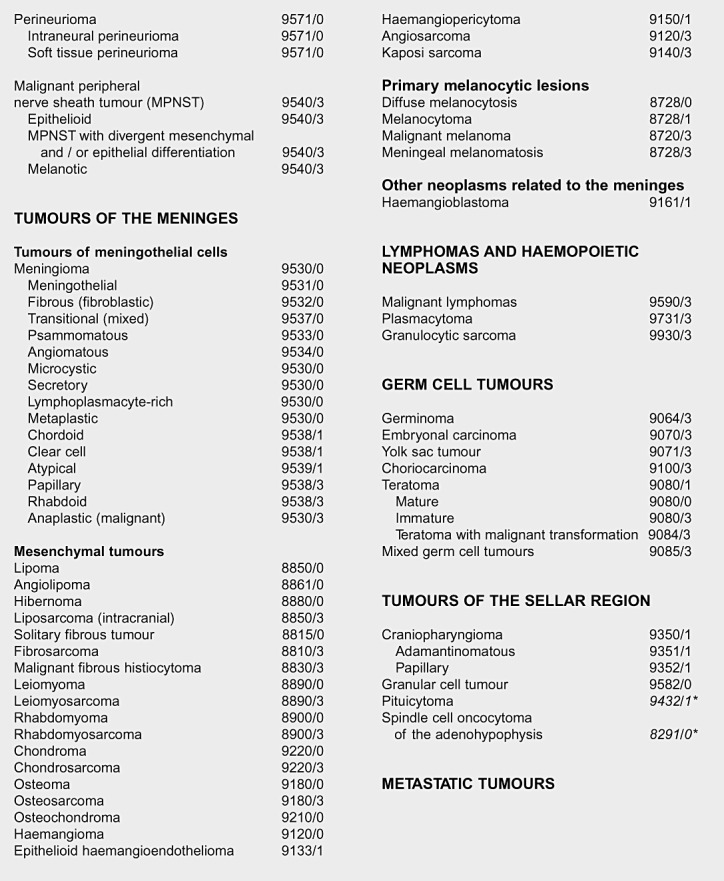Previous editions of the World Health Organization (WHO) Classification of Tumours of the Nervous System have achieved extensive utilization internationally 1, 2, 3, 5). An Editorial and Consensus Conference convened in Heidelberg on November 17–18, 2006 (Figure 1), resulting in the latest iteration of the work (4; Figure 2). Several substantive alterations distinguish the 2007 Classification from the preceding 2000 Classification, including additions, reclassifications, changes in terminology and a number of conceptual modifications. The tumor entities that have been newly codified in the 2007 Classification constitute the focus of this mini‐symposium (Table 1).
Figure 1.

The World Health Organization (WHO) 2007 Editorial and Consensus Conference Working Group. Pictured from left to right: Kenneth D. Aldape, David N. Louis, Webster K. Cavenee, Charles G. Eberhart, Otmar D. Wiestler, Daniel J. Brat, Torsten Pietsch, Hiroko Ohgaki, Paul Kleihues, Peter C. Burger, Guido Reifenberger, Dominique Figarella‐Branger, Johann A. Hainfellner, Anne Jouvet, Felice Giangaspero, V. Peter Collins, Arie Perry, Johan M. Kros, Fre T. Bosman, Roger E. McLendon, Yoichi Nakazato, Gregory N. Fuller, Andreas von Deimling, Bernd W. Scheithauer, Werner Paulus, H‐K Ng.
Figure 2.


WHO Classification of Tumours of the Nervous System. Reprinted with permission of the WHO 2007 editors.
Table 1.
Who 2007 classification of tumors of the central nervous system: newly codified entities.
| Angiocentric glioma |
| Pilomyxoid astrocytoma |
| Papillary glioneuronal tumor (PGNT) |
| Rosette‐forming glioneuronal tumor of the 4th ventricle (RGNT) |
| Papillary tumor of the pineal region (PTPR) |
| Spindle cell oncocytoma (SCO) |
| Pituicytoma |
We have chosen to use the term “newly codified” rather than “new” because several of the entities have in fact been recognized by neuropathologists for a considerable time—decades in some cases—but only recently has sufficient international consensus been reached to warrant formal codification. In contrast, other newly codified tumors are of much more recent vintage. Of these, some represent newly recognized prognostically and therapeutically significant subsets of a well‐established tumor category, and others are uncommon entities whose formal recognition has awaited accrual of sufficient histopathological data and clinical experience to permit accurate characterization of the clinicopathologic features.
Among organ systems, the diversity and complexity of tumors of the nervous system are unrivaled, and, not unexpectedly, unresolved questions of classification and grading remain and await further elucidation. Some of the more salient of these problematic issues and controversies will be presented separately in a forthcoming overview, and individual topics will subsequently be critically explored in greater detail in future issues of Brain Pathology as part of the journal’s Controversies in Pathology series.
REFERENCES
- 1. Kleihues P, Cavenee WK (1997) Pathology and Genetics of Tumours of the Nervous System. IARC: Lyon. [Google Scholar]
- 2. Kleihues P, Cavenee WK (2000) Pathology and Genetics of Tumours of the Nervous System. IARC Press: Lyon. [Google Scholar]
- 3. Kleihues P, Burger PC, Scheithauer BW (1993) Histological Typing of Tumours of the Central Nervous System. Springer‐Verlag: Berlin. [Google Scholar]
- 4. Louis DN, Ohgaki H, Wiestler OD, Cavenee WK (eds) (2007) WHO Classification of Tumours of the Central Nervous System. IARC: Lyon. [DOI] [PMC free article] [PubMed] [Google Scholar]
- 5. Zulch KJ (1979) Histological Typing of Tumours of the Central Nervous System (International Histological Classification of Tumours, N0. 21). World Health Organization: Geneva. [Google Scholar]


